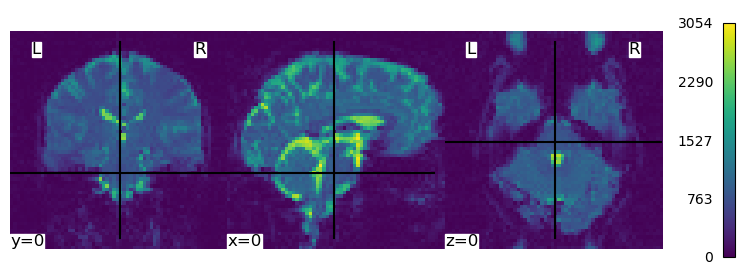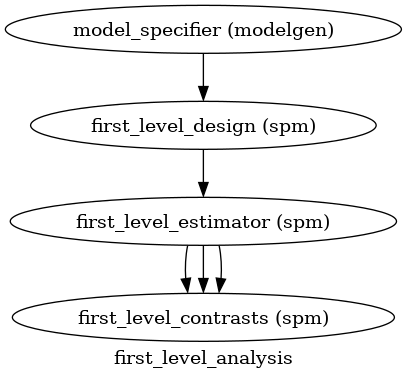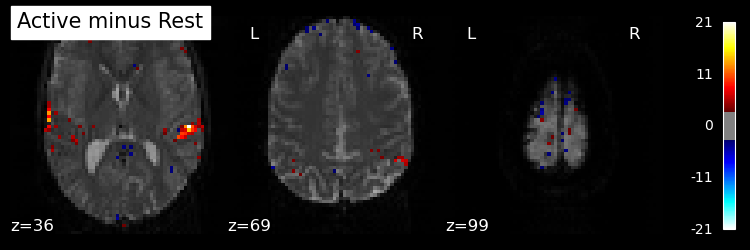First level analysis with Nipype + SPM#
Download all necessary packages#
from nipype.interfaces import spm
from nilearn.plotting import plot_anat, plot_img, plot_stat_map
from nilearn.image import index_img
from nipype import Workflow
import pandas as pd
import os
Get paths to our functional image and to our events file#
functional_img = '/data/single_files/auditory_fmri_img.nii'
events_file = '/data/single_files/auditory_events.tsv'
Plot the first 3D image of the time series#
first_volume = index_img(functional_img,0)
plot_img(first_volume, cut_coords=(0,0,0),colorbar=True, cbar_tick_format="%i")
<nilearn.plotting.displays._slicers.OrthoSlicer at 0x7f97db0c1930>

Let’s plot the events file so we know what’s going on#
events = pd.read_table(events_file)
events
| onset | duration | trial_type | amplitude | |
|---|---|---|---|---|
| 0 | 0.0 | 42.0 | rest | 1 |
| 1 | 42.0 | 42.0 | active | 1 |
| 2 | 84.0 | 42.0 | rest | 1 |
| 3 | 126.0 | 42.0 | active | 1 |
| 4 | 168.0 | 42.0 | rest | 1 |
| 5 | 210.0 | 42.0 | active | 1 |
| 6 | 252.0 | 42.0 | rest | 1 |
| 7 | 294.0 | 42.0 | active | 1 |
| 8 | 336.0 | 42.0 | rest | 1 |
| 9 | 378.0 | 42.0 | active | 1 |
| 10 | 420.0 | 42.0 | rest | 1 |
| 11 | 462.0 | 42.0 | active | 1 |
| 12 | 504.0 | 42.0 | rest | 1 |
| 13 | 546.0 | 42.0 | active | 1 |
| 14 | 588.0 | 42.0 | rest | 1 |
| 15 | 630.0 | 42.0 | active | 1 |
Use Nipype & SPM to conduct a first level analysis#
from nipype import Node
from nipype.interfaces.spm import Level1Design, EstimateModel, EstimateContrast
from nipype.algorithms.modelgen import SpecifySPMModel
Specify everything that SPM needs#
model_specifier = Node(SpecifySPMModel(concatenate_runs=False,
input_units='secs',
output_units='secs',
time_repetition=7,
high_pass_filter_cutoff=128,
functional_runs = ['/data/single_files/auditory_fmri_img.nii'],
bids_event_file = ['/data/single_files/auditory_events.tsv']
),
name='model_specifier')
# Level1Design - Generates an SPM design matrix
first_level_design = Node(Level1Design(bases={'hrf':{'derivs': [0,0]}},
interscan_interval=7,
timing_units='secs',
model_serial_correlations='FAST'),
name='first_level_design')
# EstimateModel - estimate the parameters of the model
first_level_estimator = Node(EstimateModel(estimation_method={'Classical': 1}),name='first_level_estimator')
## EstimateContrast - estimate contrasts
contrast_1 = ('Active > Rest','T', ['active','rest'],[1,-1])
contrast_2 = ('Rest > Active','T', ['active','rest'],[-1,1])
first_level_contrasts = Node(EstimateContrast(), name='first_level_contrasts')
first_level_contrasts.inputs.contrasts = [contrast_1,contrast_2]
Connect all nodes to a Workflow#
# define workflow
from nipype import Workflow
wf = Workflow(name='first_level_analysis',base_dir='/cache')
wf.connect(model_specifier,'session_info',first_level_design,'session_info')
wf.connect(first_level_design,'spm_mat_file',first_level_estimator,'spm_mat_file')
wf.connect(first_level_estimator,'spm_mat_file',first_level_contrasts,'spm_mat_file')
wf.connect(first_level_estimator,'beta_images',first_level_contrasts,'beta_images')
wf.connect(first_level_estimator,'residual_image',first_level_contrasts,'residual_image')
Plot the workflow#
# Create 1st-level analysis output graph
wf.write_graph()
from IPython.display import Image
Image(filename='/cache/first_level_analysis/graph.png')
231129-16:41:42,582 nipype.workflow INFO:
Generated workflow graph: /cache/first_level_analysis/graph.png (graph2use=hierarchical, simple_form=True).

Run the workflow#
wf.run()
Plot the statistical image#
# Plot the image
from nilearn.image import load_img
from nilearn.image import mean_img
from nilearn.plotting import plot_stat_map
# create a background image using the average of our functional image
mean_img = mean_img(functional_img)
# load the contrast image
contrast_img = load_img('/cache/first_level_analysis/first_level_contrasts/spmT_0001.nii')
# plot contrast on top functional image
plot_stat_map(stat_map_img=contrast_img,
bg_img=mean_img,
threshold=3.0,
display_mode="z",
cut_coords=3,
black_bg=True,
title="Active minus Rest",
)
<nilearn.plotting.displays._slicers.ZSlicer at 0x7f97daef7d60>

The ‘first_level_analysis’ folder looks nasty. Can’t we make it more pretty?#
# Yes we can! By defining a DataSink node where files should be stored
from nipype.interfaces.io import DataSink
datasink = Node(DataSink(base_directory='/output'),name="datasink")
wf.connect(first_level_contrasts,'spmT_images',datasink,'spm_contrast_images')
wf.run()
I always can’t remember what the numbers in T_xxxx stand for…#
# let's remove the last datasink node, redefine it and reconnect it again
wf.remove_nodes([datasink])
datasink = Node(DataSink(base_directory='/output',
substitutions=[('spmT_0001.nii','active_greater_rest.nii'),
('spmT_0002.nii','rest_greater_active.nii')]),
name="datasink")
wf.connect(first_level_contrasts,'spmT_images',datasink,'spm_contrast_images')
wf.run()

